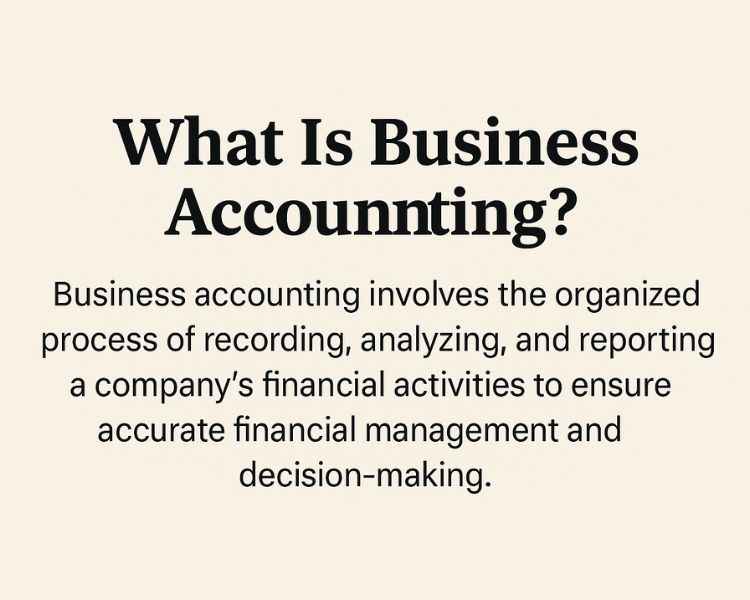Running a successful business isn’t just about offering great products or services—it’s also about managing your finances effectively. Understanding accounting basics is essential for any entrepreneur who wants to grow sustainably, stay compliant with the law, and make sound financial decisions.
This guide will walk you through the fundamentals of business accounting, key financial statements, important terms, and practical steps to get started with accounting for your business in Australia.
What Is Business Accounting?
Business accounting involves the organized process of recording, analyzing, and reporting a company’s financial activities to ensure accurate financial management and decision-making.
It’s a vital process that helps business owners track income, expenses, liabilities, and overall financial performance.
By maintaining accurate and timely records, you gain a clear picture of your company’s financial health. This, in turn, helps you make informed decisions, secure financing, and meet legal obligations.

Why Is Accounting Crucial for Business Success?
Accounting plays a pivotal role in business for several reasons:
- Financial clarity – It shows where your money is going and helps manage cash flow.
- Compliance – Accurate accounting ensures you meet tax and reporting obligations.
- Decision-making – With up-to-date records, you can identify growth opportunities or areas needing improvement.
- Investor confidence – Stakeholders, including investors and lenders, require financial transparency.
Understanding the Accounting Basics
Before diving deeper, let’s get familiar with the core concepts that make up accounting. These terms are the foundation of financial literacy for any business owner.
Common Accounting Terms
- Assets – Resources a business owns that have monetary value (e.g., equipment, inventory, accounts receivable).
- Liabilities – Debts or financial obligations owed to others (e.g., loans, accounts payable).
- Equity – The owner’s residual interest in the business after liabilities are subtracted from assets.
- Revenue – The total income generated from business activities.
- Expenses – The costs incurred while operating a business, such as rent, salaries, and utilities.
Chart of Accounts
The chart of accounts is an organized framework that lists every account a business uses to classify its financial transactions. It usually includes categories like:
- Assets (e.g., cash, accounts receivable, equipment)
- Liabilities (e.g., loans, taxes payable)
- Equity (e.g., owner’s capital)
- Income (e.g., sales, service revenue)
- Expenses (e.g., rent, marketing, salaries)
Each account has a unique identifier for efficient tracking and classification.
Key Financial Statements
Financial statements provide a clear overview of your business’s financial health and performance. The four main types you should know are:
1. Income Statement (Profit and Loss Statement)
Shows your business’s revenues and expenses over a specific period. It helps determine whether your business is making a profit or a loss.
Includes:
- Sales revenue
- Cost of goods sold (COGS)
- Operating expenses
- Net income or loss
2. Balance Sheet
Provides a snapshot of your business’s financial position at a specific point in time.
Includes:
- Current and non-current assets
- Current and long-term liabilities
- Owner’s equity
3. Cash Flow Statement
Details how cash moves into and out of your business, divided into:
- Operating activities
- Investing activities
- Financing activities
Includes:
- Cash from sales
- Equipment purchases
- Loan repayments or capital injections
4. Bank Reconciliation
Matches your accounting records with your bank statements to ensure consistency and catch any discrepancies or errors.
Accounting Methods: Cash vs Accrual
Choosing the right accounting method is essential:
- Cash Method – Records income and expenses when money is received or paid. Best for small businesses.
- Accrual Method – Records income when earned and expenses when incurred, regardless of cash movement. Offers a fuller picture.
Essential Steps to Begin Accounting for Your Business
If you’re new to accounting, follow these steps:
1. Open a Business Bank Account
Keep business and personal finances separate for clearer records and easier bookkeeping.
2. Set Up a Chart of Accounts
Use this to track income and expenses. Most accounting tools provide templates you can customise.
3. Choose an Accounting System
Decide between spreadsheets or software like Xero, MYOB, or QuickBooks for automation and reporting.
4. Record All Transactions
Document every sale, expense, and payment. Keep receipts and statements for tax time.
5. Understand Your Tax Obligations
In Australia, this includes:
- GST (Goods and Services Tax)
- PAYG Withholding
- Superannuation
- Company Tax
Tip: Always consult a registered tax professional.
6. Reconcile Monthly
Match your bank and accounting records regularly to spot errors early and ensure accuracy.
7. Establish a Payroll System
If you employ staff, manage wages, taxes, and super. Stay compliant with Fair Work and ATO rules.
8. Hire an Accounting Professional
A qualified accountant or bookkeeper can help with tax returns, financial planning, and compliance.
Types of Accounting Professionals
- Accountant – Handles tax prep, financial reports, and business advice.
- Bookkeeper – Manages daily financial transactions and reconciliations.
- BAS Agent – Specialises in preparing and lodging Business Activity Statements with the ATO.
Final Thoughts
Understanding accounting basics is a smart investment in your business’s future. Once you learn the key terms, statements, and processes, you’ll feel more confident and in control.
Make accounting a habit—not a hassle—and your business will be stronger for it.